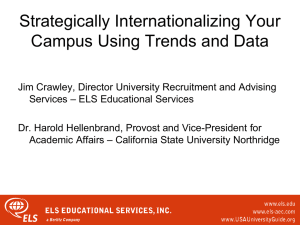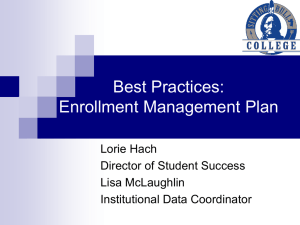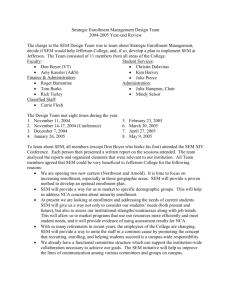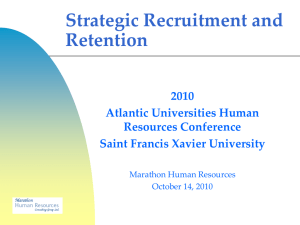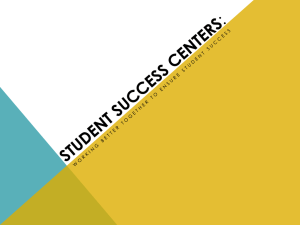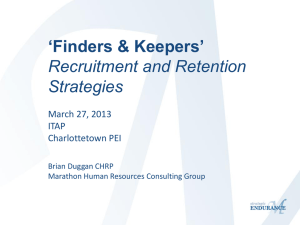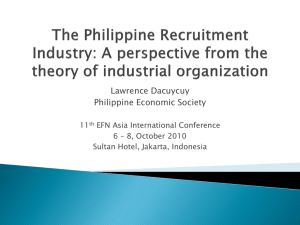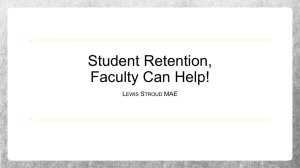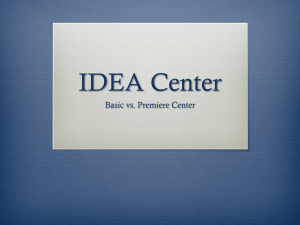PDF , 850 KB - CBIE – BCEI
advertisement
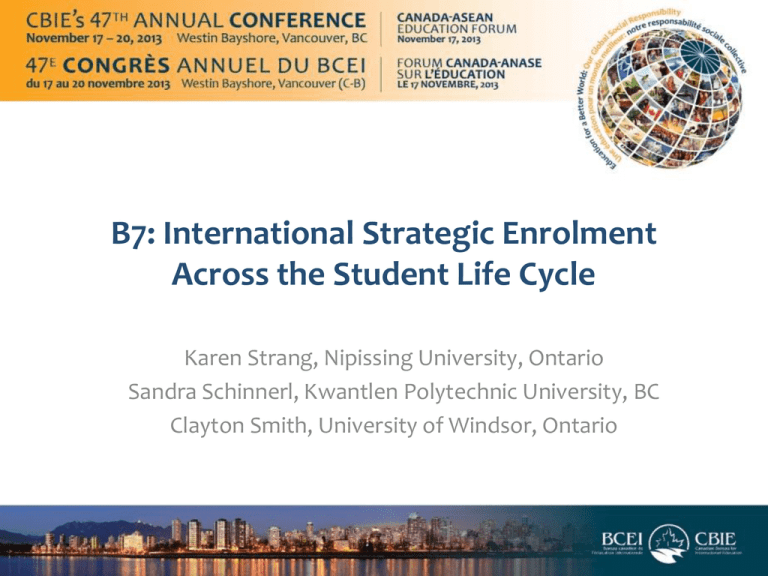
B7: International Strategic Enrolment Across the Student Life Cycle Karen Strang, Nipissing University, Ontario Sandra Schinnerl, Kwantlen Polytechnic University, BC Clayton Smith, University of Windsor, Ontario Questions • Do you have experience with International Strategic Enrolment Management? • Does your institution have: – an international student recruitment plan? – an international student retention plan? 2 Topics • • • • • • • Overview of International SEM A Case Study I-SEM, Stakeholders & PLCs University of Windsor Story Summary Resources Questions & Comments 4 Enrollment Management: The Classical Definition Enrollment management is an organizational concept and a systematic set of activities designed to enable educational institutions to exert more influence over their student enrollments. Organized by strategic planning and supported by institutional research, enrollment management activities concern student college choice, transition to college, student attrition and retention, and student outcomes. These processes are studied to guide institutional practices in the areas of new student recruitment and financial aid, student support services, curriculum development and other academic areas that affect enrollments, student persistence and student outcomes from college. - Hossler, 1990 5 What is International Strategic Enrollment Management? Using SEM principles in the context of international students and how they relate to your institution’s mission and the educational goals of the students recruited and enrolled. -Braxton & Conroy, 2008 6 SEM is Achieved by… Establishing clear goals for the number & types of students Promoting student academic success by improving access, transition, retention, & graduation Enabling effective strategic & financial planning Supporting the delivery of effective academic programs 7 SEM is Achieved by (Cont’d)… Creating a data-rich environment to inform decisions & evaluate strategies Improving process & organizational efficiency Establishing top quality student-centered service Strengthening communications & collaboration among departments across the campus - Bontrager, 2004 8 SEM Ethos A shared responsibility Integrated institutional planning A focus on service Accountability Research & evaluation For the long haul -Henderson, 2005 9 Importance of Assessment DATA - What puts the “S” in “SEM” Transactional data Recruitment and retention analysis Assessment of strategies, services and outcomes 10 Creating a Data-Driven Enrolment Plan The Enrollment Data Agenda Alumni Research Enrollment Strategies Active Alumni Placement Data Graduate Rates Graduated Retention Data Student Surveys Engaged, Satisfied Alumni engagement Graduation/ Career Development First Year Exp. & Retention Programs Retained Financial Aid Analysis Enrolled Yield Data Admission Statistics Deposited Applied/Admitted Competitive Analysis Market Research Yield Recruitment Marketing Prospective Students 11 11 Case Study Discussion • Read through the brief case study • Working in groups of two or 3 discuss the questions that follow the case study • Be prepared to share an insight or suggestion from one of your group members when we discuss in a larger group 12 Case Study Discussion • Which initiatives would be considered part of International Strategic Enrollment Management? • What suggestions do you have for the campus units that did not get their initiatives funded? • What types of benchmarking or assessment tools would you suggest are put in place to assist in making resource decisions? 13 I-SEM & Stakeholders (International - Strategic Enrolment Management) Institutional commitment to I-SEM Align with institutional vision and strategic plan Budget must be focused and avoid duplication Ensure human resources for all aspect of the I-SEM: promotion, recruitment, retention, alumni Who are your I-SEM committee members? Reflective of key stakeholders TOR - Goals - Measured Outcomes Benefits of engaging stakeholders Unified institutional approach Understanding and appreciation of influence on department and personnel Intercultural competency development across the institution 14 Stakeholder Engagement Objectives (regarding I-SEM) Objective or Aspect Why engage? Outputs Outcomes Create an I-SEM strategy -produce institutional policy for I-SEM involving all levels -awareness and buy-in across administrative and academic departments -align with strategic plan -view as a form of risk management To ensure stakeholders contribute to: -knowledge and understanding of ISEM -shared understanding of the influence/impact on departments and staff 15 Cycle of Stakeholder Engagement in the I-SEM Agenda Setting - use feedback from all stakeholders - to identify progress or barriers - set targets or strategy for future initiatives - developing ideas, expressing views - current data - influence of IS on academic and admin departments - support services – retention Review Evaluation Future - meet regularly - seek stakeholder views on implementation and refine plan Implementation Analysis I-SEM Formulation - research I-SEM model - stakeholders and decision makers come together - identify challenges and opportunities - workable solutions, gain feedback - implementation of policies - increase in financial or human resources - which dept. is the mobilizing unit? 16 SEM & Professional Learning Communities • CBIE PLCs – Facilitate discussion and document sharing – Discuss major issues/concerns – Share best practices – Share resources, statistics, – Undertake projects • e.g. templates or agreements to work with agents, • e.g. use of “Imagine Study au/in Canada” brand 17 The University of Windsor Story 18 A look at Student Recruitment Formed a Working Group Internal challenges External challenges Conducted a financial audit and operational review Commissioned an external benchmarking study from a US-based higher education consulting firm – Education Advisory Board Obtained consulting services from a UK-based international higher education consulting firm Global Higher Educational Consulting, Inc. A Multi-Channel Plan 1. Adopt a broad-based student recruitment model that discontinues exclusivity with a single recruitment firm and identifies major student recruitment agencies that operate successfully in key markets, such as China, India, the Middle East and South Asia. 2. Develop in-house capacity to encourage direct applications and to manage applications and offers efficiently. This will involve making infrastructure investments in such areas as web and social media, international marketing, admissions, and study permit advice. 20 A Multi-Channel Plan (Cont’d) 3. Develop a range of transfer articulation agreements with university partners around the world that will permit students to enter the University (both graduate and undergraduate) with advanced standing through 1+3, 2+2 and 3+1 links. 4. Establish local University offices in key markets, such as India and China, to market and recruit students directly. Such offices could also support in-country university partnership and research development, alumni outreach and institutional advancement. 21 A Multi-Channel Plan (Cont’d) 5. Develop a University pathways program for students who have not reached the University’s entrance requirements. This will involve teaching English language, study skills, and some academic coursework. This could also result in the development of a pre-master’s pathways program. 6. Explore the delivery of part or whole programs outside Canada. This will result in brand awareness and the development of articulation links in other countries. 22 A Multi-Channel Plan (Cont’d) 7. Develop ways to use alumni as ambassadors for the University in recruiting new students (e.g., recruitment fairs abroad). 8. Create more connectivity between the recruitment program and the Faculties, especially the deans, and senior administration to ensure both transparency and accountability. 23 Agent Agent Agent Agent Agent Agent Fairs Regional Office (R#4) Regional Office (R#4) Regional Office (R#4) Alumni Overseas Programs (R#6) Pathways (R#5) Articulations (R#3) University of Windsor International Student Recruitment Infrastructure/In-house Capacity (R#2) 24 A Look at Student Retention • Conducted a study of international student retention: – Qualitative – Quantitative • Participated in the International Student Barometer Our Purpose • To identify the factors that contribute to attrition of international students at the University of Windsor to determine what might be done to improve the success and persistence of international students academically, through support initiatives and in our student recruitment program. 26 Methodology Pre-Study environmental scan Pilot study Focus groups Service provider interviews Faculty interviews On-line survey: students On-line survey: faculty On-line survey: service providers 27 Differing Perspectives Factor Faculty Service Providers Students Language 1 1 - Culture 2 2 1 Racism & Discrimination 3 3 4 Frustration, Disorientation & Confusion - - 2 Facilities & Services - - 3 ...but agreement on Language and Culture Factors Affecting Retention Social Environmental Linguistic International Student Familial Economic Academic Cultural Smith & Demjanenko, 2011 29 Australia Malaysia Canada Netherlands Estonia New Zealand Finland Singapore Germany South Africa Hong Kong Sweden Ireland UK Italy USA 209,422 international students responded to the 2011 survey from 238 institutions in 16 countries ; 6.227 students surveyed at Ontario universities The ISB: University of Windsor, Ontario Universities & Canada Satisfaction UW vs. ISB UW vs. Ontario UW vs. Canada Benchmark 2010 2011 Change 2010 2011 2010 2011 Arrival 82% 82.4% 0.4% 1 -0.4 1 -0.6 - -0.5 Support 85% 89.2% 4.2% -3 -0.8 2 1.3 - 0.9 Learning 83% 82.7% -0.3% -1 -2.1 1 -2 - -2 Living 74% 76.2% 2.2% -3 -2.6 1 -1.3 - -1.6 Our strengths are arrival and support 2010 2011 Arrival • Areas of Strength: – Registration – University orientation – Financial (banking) information • Areas of Improvement: – First night – Condition of accommodation – Meeting faculty members – Social activities i-graduate, 2011 Support • High Institutional Usage/High Satisfaction: – Student Centre – International Students’ Centre – Student Health Services • High Institutional Usage/Low Satisfaction: – Cashiers – Graduate Studies – Market Place (Student Centre) i-graduate, 2011 Learning • High Institutional Usage/High Satisfaction: – Quality lectures – Learning support – Learning spaces • High Institutional Usage/Low Satisfaction: – Work experience – Career advice (faculty) – Research activity i-graduate, 2011 Living • High Institutional Usage/High Satisfaction: – Sports facilities – Social activities – Eco-friendly • High Institutional Usage/Low Satisfaction: – Financial support – Transport links – Earning money i-graduate, 2011 Next Up • Development of an international student retention action plan 36 Summary 1. Assessment is key to determining the success of initiatives we undertake. Benchmark progress and let data drive decision-making. 2. Resources must be allocated to ensure that the strategies put in place have a lasting impact on students. 3. The enrolment funnel and student life cycle experience may be different for different groups of international students. Strategies need to be customized. 37 Summary (Cont’d) 4. Retention is another word for “home away from home”. 5. Racism draws a distinction between experiences in which international students thrive or survive the student experience. 6. We need to work collaboratively across our campuses to develop shared, institution-wide definition of campus internationalization. 7. Share ideas, concepts, tools and processes with your Canadian counterparts ... create a PLC - I-SEM (CBIE Professional Learning Community focused on International Student Enrolment Management). 38 Resources British Council: http://www.britishcouncil.org/ Canadian Bureau of International Education: http://www.cbie-bcei.ca/ Canadian SEM Website: www.uwindsor.ca/sem European Association of International Education: http://www.eaie.org/ I-Graduate: International Student Barometer: http://www.igraduate.org/services/international-student-barometer-and-studentbarometer/ NAFSA: http://www.nafsa.org/ • Stakeholder Engagement Toolkit (source: REVIT project from EU) http://www.revitnweurope.org/selfguidingtrail/27_Stakeholder_engagement_a_toolkit2.pdf • Stakeholder Engagement Practitioner Handbook - article "Leading for Results" (source: Canadian conference in Banff) http://www.banffcentre.ca/leadership/library/pdf/LC7_Stakeholders_artic le.pdf 39 Questions & Comments • Karen Strang, karens@nipissingu.ca • Sandra Schinnerl, Sandra.Schinnerl@kpu.ca • Clayton Smith, csmith@uwindsor.ca 40
